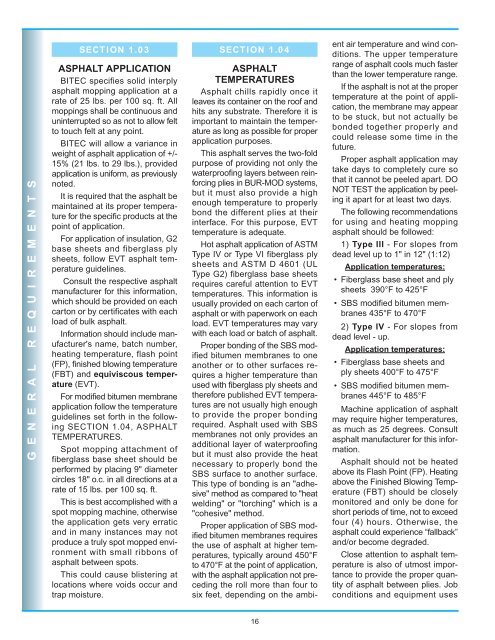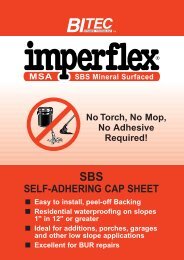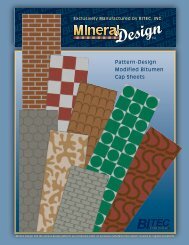Roofing Material Specifications and Details - BITEC, Bitumen ...
Roofing Material Specifications and Details - BITEC, Bitumen ...
Roofing Material Specifications and Details - BITEC, Bitumen ...
Create successful ePaper yourself
Turn your PDF publications into a flip-book with our unique Google optimized e-Paper software.
G E N E R A L R E Q U I R E M E N T S<br />
SECTION 1.03<br />
ASPHALT APPLICATION<br />
<strong>BITEC</strong> specifies solid interply<br />
asphalt mopping application at a<br />
rate of 25 lbs. per 100 sq. ft. All<br />
moppings shall be continuous <strong>and</strong><br />
uninterrupted so as not to allow felt<br />
to touch felt at any point.<br />
<strong>BITEC</strong> will allow a variance in<br />
weight of asphalt application of +/-<br />
15% (21 lbs. to 29 lbs.), provided<br />
application is uniform, as previously<br />
noted.<br />
It is required that the asphalt be<br />
maintained at its proper temperature<br />
for the specific products at the<br />
point of application.<br />
For application of insulation, G2<br />
base sheets <strong>and</strong> fiberglass ply<br />
sheets, follow EVT asphalt temperature<br />
guidelines.<br />
Consult the respective asphalt<br />
manufacturer for this information,<br />
which should be provided on each<br />
carton or by certificates with each<br />
load of bulk asphalt.<br />
Information should include manufacturer's<br />
name, batch number,<br />
heating temperature, flash point<br />
(FP), finished blowing temperature<br />
(FBT) <strong>and</strong> equiviscous temperature<br />
(EVT).<br />
For modified bitumen membrane<br />
application follow the temperature<br />
guidelines set forth in the following<br />
SECTION 1.04, ASPHALT<br />
TEMPERATURES.<br />
Spot mopping attachment of<br />
fiberglass base sheet should be<br />
performed by placing 9" diameter<br />
circles 18" o.c. in all directions at a<br />
rate of 15 lbs. per 100 sq. ft.<br />
This is best accomplished with a<br />
spot mopping machine, otherwise<br />
the application gets very erratic<br />
<strong>and</strong> in many instances may not<br />
produce a truly spot mopped environment<br />
with small ribbons of<br />
asphalt between spots.<br />
This could cause blistering at<br />
locations where voids occur <strong>and</strong><br />
trap moisture.<br />
SECTION 1.04<br />
ASPHALT<br />
TEMPERATURES<br />
Asphalt chills rapidly once it<br />
leaves its container on the roof <strong>and</strong><br />
hits any substrate. Therefore it is<br />
important to maintain the temperature<br />
as long as possible for proper<br />
application purposes.<br />
This asphalt serves the two-fold<br />
purpose of providing not only the<br />
waterproofing layers between reinforcing<br />
plies in BUR-MOD systems,<br />
but it must also provide a high<br />
enough temperature to properly<br />
bond the different plies at their<br />
interface. For this purpose, EVT<br />
temperature is adequate.<br />
Hot asphalt application of ASTM<br />
Type IV or Type VI fiberglass ply<br />
sheets <strong>and</strong> ASTM D 4601 (UL<br />
Type G2) fiberglass base sheets<br />
requires careful attention to EVT<br />
temperatures. This information is<br />
usually provided on each carton of<br />
asphalt or with paperwork on each<br />
load. EVT temperatures may vary<br />
with each load or batch of asphalt.<br />
Proper bonding of the SBS modified<br />
bitumen membranes to one<br />
another or to other surfaces requires<br />
a higher temperature than<br />
used with fiberglass ply sheets <strong>and</strong><br />
therefore published EVT temperatures<br />
are not usually high enough<br />
to provide the proper bonding<br />
required. Asphalt used with SBS<br />
membranes not only provides an<br />
additional layer of waterproofing<br />
but it must also provide the heat<br />
necessary to properly bond the<br />
SBS surface to another surface.<br />
This type of bonding is an "adhesive"<br />
method as compared to "heat<br />
welding" or "torching" which is a<br />
"cohesive" method.<br />
Proper application of SBS modified<br />
bitumen membranes requires<br />
the use of asphalt at higher temperatures,<br />
typically around 450°F<br />
to 470°F at the point of application,<br />
with the asphalt application not preceding<br />
the roll more than four to<br />
six feet, depending on the ambi-<br />
16<br />
ent air temperature <strong>and</strong> wind conditions.<br />
The upper temperature<br />
range of asphalt cools much faster<br />
than the lower temperature range.<br />
If the asphalt is not at the proper<br />
temperature at the point of application,<br />
the membrane may appear<br />
to be stuck, but not actually be<br />
bonded together properly <strong>and</strong><br />
could release some time in the<br />
future.<br />
Proper asphalt application may<br />
take days to completely cure so<br />
that it cannot be peeled apart. DO<br />
NOT TEST the application by peeling<br />
it apart for at least two days.<br />
The following recommendations<br />
for using <strong>and</strong> heating mopping<br />
asphalt should be followed:<br />
1) Type III - For slopes from<br />
dead level up to 1" in 12" (1:12)<br />
Application temperatures:<br />
• Fiberglass base sheet <strong>and</strong> ply<br />
sheets 390°F to 425°F<br />
• SBS modified bitumen membranes<br />
435°F to 470°F<br />
2) Type IV - For slopes from<br />
dead level - up.<br />
Application temperatures:<br />
• Fiberglass base sheets <strong>and</strong><br />
ply sheets 400°F to 475°F<br />
• SBS modified bitumen membranes<br />
445°F to 485°F<br />
Machine application of asphalt<br />
may require higher temperatures,<br />
as much as 25 degrees. Consult<br />
asphalt manufacturer for this information.<br />
Asphalt should not be heated<br />
above its Flash Point (FP). Heating<br />
above the Finished Blowing Temperature<br />
(FBT) should be closely<br />
monitored <strong>and</strong> only be done for<br />
short periods of time, not to exceed<br />
four (4) hours. Otherwise, the<br />
asphalt could experience “fallback”<br />
<strong>and</strong>/or become degraded.<br />
Close attention to asphalt temperature<br />
is also of utmost importance<br />
to provide the proper quantity<br />
of asphalt between plies. Job<br />
conditions <strong>and</strong> equipment uses




